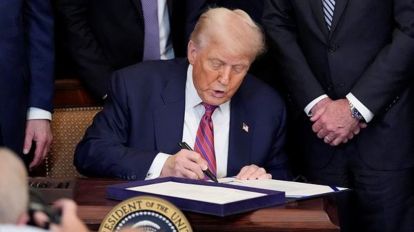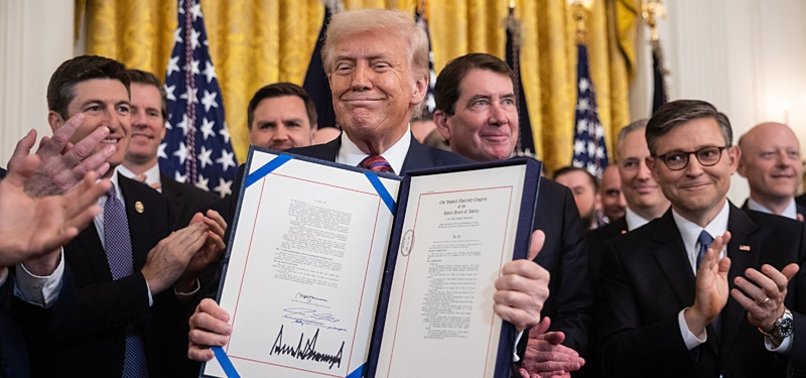A Landmark Move from the White House
In a move sending ripples across both political and financial circles, former President Donald Trump has officially signed a new law focused on stablecoins—marking a pivotal moment for the digital currency sector. The legislation, formally titled the “Stablecoin Innovation and Transparency Act,” lays out the first comprehensive federal guidelines for issuing and regulating stablecoins in the United States.
The bill passed both chambers of Congress after months of contentious debates between lawmakers, financial regulators, and crypto advocates. Trump’s signature on this law reflects not just a political stance but a shift in how digital currencies are being perceived by U.S. leadership. For a space once labeled as fringe and speculative, the legal codification of stablecoins sets a significant precedent.
What the Law Covers
This new federal law defines what constitutes a stablecoin and establishes rules for its issuance, reserve requirements, and auditing standards. It mandates that any entity issuing stablecoins must hold dollar-equivalent reserves in audited, regulated institutions like banks or credit unions. Furthermore, the law requires transparent disclosures, annual audits, and real-time public reporting of reserves to build trust in the system.
Regulators such as the Office of the Comptroller of the Currency (OCC) and the Securities and Exchange Commission (SEC) have been assigned new roles in overseeing stablecoin operations. Startups and existing crypto platforms now must either obtain a federal license or partner with institutions that already hold one.
For many in the financial technology world, this is not just a legal adjustment—it’s an invitation to build new services on solid regulatory ground. The law aims to strike a balance between innovation and consumer protection, providing a safer onramp for institutional investors and retail users alike.
Industry Reaction and Strategic Positioning

The response from the digital currency industry has been swift and largely positive. Coinbase, Circle, and other major crypto firms released statements praising the law for offering long-needed clarity. Jeremy Allaire, CEO of Circle—the company behind USDC—described the legislation as “a major step forward for responsible digital finance.”
Meanwhile, smaller fintech firms are viewing the law as a validation of their efforts to bridge the gap between traditional finance and blockchain infrastructure. This legal backing opens doors for partnerships with banks, institutional custodians, and even government agencies.
With this law now in effect, the race to become the most trusted stablecoin issuer in the United States is intensifying. Companies are quickly adapting their compliance structures and strengthening reserve mechanisms to meet federal expectations. For some, this means reevaluating offshore strategies and shifting back to U.S.-regulated operations—a major turning point for crypto business models that historically prioritized decentralization and borderless functionality.
In this context, the crypto industry’s pursuit of mainstream adoption becomes not just an aspiration, but a concrete strategy bolstered by legislative support.
Political Messaging and 2024 Implications
Trump’s involvement in crypto policy might come as a surprise to some, especially given his previously skeptical stance on Bitcoin and decentralized finance. However, the stablecoin law could be part of a larger political strategy aimed at appealing to younger voters, fintech entrepreneurs, and libertarian-leaning conservatives.
Some political analysts believe Trump’s decision to back stablecoin legislation may also be tied to his broader views on financial independence and distrust of traditional banking institutions. In a landscape where crypto ownership among Americans has grown steadily, aligning with digital finance could be a shrewd move.
It’s worth noting that the Democratic response has been cautious. While some Democrats co-sponsored the bill, others expressed concerns over potential loopholes that could be exploited without tighter oversight. Still, bipartisan support ensured the bill’s passage, a rare occurrence in today’s political climate.
The Role of Banks and Wall Street
With the federal green light on stablecoins, traditional financial players are no longer sitting on the sidelines. Banks such as JPMorgan Chase and Bank of America have already announced pilot programs to explore issuing their own compliant stablecoins or facilitating third-party transactions.
Wall Street sees opportunity, especially in areas like cross-border payments, digital asset custody, and DeFi integration with institutional frameworks. Analysts suggest that stablecoins could now become the backbone of a new form of settlement architecture, possibly replacing outdated systems like SWIFT for certain types of transactions.
This law also gives central banks around the world a clearer idea of where the U.S. stands on digital currency frameworks. While the Federal Reserve has not yet issued a digital dollar, many experts view the stablecoin regulation as a complementary step that prepares the economy for wider adoption of blockchain-based financial tools.
Consumer Impact and Public Trust
For everyday users, the new law could enhance the legitimacy of stablecoins as a payment tool and store of value. With required transparency, users may feel more confident transacting with digital dollars, whether for online shopping, remittances, or peer-to-peer payments.
The law’s emphasis on reserve backing means that stablecoins must be redeemable at face value, providing a safeguard against liquidity crises and market shocks. This is a critical step for public trust, especially after events like the collapse of algorithmic stablecoins such as TerraUSD, which rocked investor confidence in 2022.
Developers of apps and wallets plan to update their compliance protocols and user interfaces to meet the new requirements. Developers now have a legal foundation to innovate without fear of regulatory whiplash. That consistency can attract new users from mainstream sectors who previously avoided crypto due to its murky legal status.
Global Implications for Digital Currency Policy
International observers are watching closely. Countries like the UK, Singapore, and Japan have been experimenting with their own versions of stablecoin regulation. Trump’s move gives the U.S. a leading voice in shaping global digital finance norms.
This legal framework might push international regulatory bodies to harmonize standards for stablecoin issuance and cross-border use. In turn, that could accelerate the growth of interoperable blockchain systems that can function across jurisdictions, boosting liquidity and reducing friction in global trade.
For multinational corporations and remittance-focused platforms, the stablecoin law creates a viable legal path to expand services globally while maintaining compliance with U.S. law.




